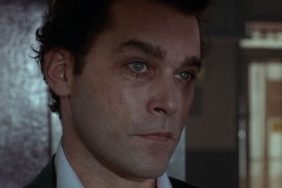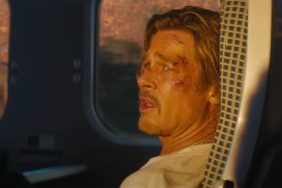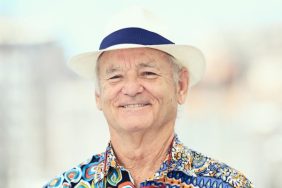The Grey is due out on home video May 15. Did you see The Grey? It was a very well made, and rather desolate look at the tentative survival of a group of miners who crash land in the snowy wilds of Alaska, and are beset by a pack of angry wolves. While many expected the film to be mere animal mayhem, featuring the big-fisted Liam Neeson punching wild animals in the face, it turned out to be far more thoughtful, philosophical and bleak.
As such, we have been brainstorming other man vs. nature films. The genre of humanity fighting off some sort of natural threat (or sometimes one another) is vast and broad. Indeed, when it comes to films that fall under the aegis of “survival films,” there are subgenres within the subgenre. We wanted to come up with a top ten list of man vs. nature films, but the topic was too vast (and how many more times can people talk about Jaws?). As such, we have come up with some rules:
1) No Disaster Films. Surviving a cave-in or an earthquake or a capsized ship may have been a situation created by nature, but those are special cases. 2) No Post-Apocalyptic Movies. The natural world is insidious enough as is. We don’t need to have a burned-out wasteland of mutants and radiation to compound matters. 3) No Monsters. Again, there are plenty of real-life killer animals in the world without the addition of graboids or sharktopi. 4) No Man-Hunting-Man films. The Most Dangerous Game is well known. The manhunting films are, in my mind, something else entirely.
So the rules are thus: People in the wild, fighting of nature in its unaltered-by-radiation form. Tales of survival in the face of the natural world. Animal attacks are fine, so long as they are real animals. Mere harsh conditions also count. So now that we’re all clear, here are The Top Ten Man vs. Nature Movies.


There were a few words of chemical imbalance, but those are only vaguely whispered in this hikers-in-peril film from the 1970s. The popularity of Jaws launched a string of killer animal imitators for over the following decades, leading to killer alligators, killer bats, killer warthogs, and even killer frogs. In an attempt to outdo them all, Day of the Animals has an entire forest of creatures attack a group of hapless hikers. No one really knows why, but the bulk of the film is spent with a dwindling number of humans as they are killed off by bears, cougars, eagles, and anything else that lives in the woods. Leslie Nielsen, in his pre-Airplane! days, plays the tough-minded survivalist who barks orders to his frightened co-hikers. For a generation raised on Nielsen as a comedy icon, it’s weird to watch him go mad and threaten to rape a woman right before a bear mauls him. It’s campy, but it’s way fun.


The story is very simple: A man (Tom Hanks) who lives by the clock, and devotes his every second to delivering packages on time, finds himself stranded on a desert island. There, he must find food and learn to survive and how to keep his sanity amidst the crushing isolation. And while there are no great revelations in this high-profile survival flick, I appreciated its bloody-minded mechanical look at the ins and outs of survival. Just how would you build a shelter? Just how would you feed yourself? How easy is it to build a fire if you’re a city-dweller who is used to microwave ovens? And, in the film’s most interesting wrinkle, how do you create company for yourself? Cast Away gives Hanks a volleyball for company, and we oddly begin to see it as another character in the piece. Not complex, but well made, and missing those uncomfortable imperial underpinnings of Robinson Crusoe.


A survival tale that feels more like a Dada experiment than an actual harrowing survival film, Gerry was the first in Gus Van Sant’s kind-of-based-on-a-harrowing-true-story trilogy, which also included Elephant and Last Days. The story features two young men (Matt Damon and Casey Affleck), both named Gerry, who, without much explanation, find themselves lost in the desert. They speak in a Beckett-like imaginary patois, inventing words like “shirtbasket” and “dirtmattress,” and using the word Gerry as a verb. Most of the film, though, is the two men, totally silent, walking in a straight line through the desert. We hear the crunch of their footsteps. The isolation and lack of incident eventually begins to drive them both mad. They may be hallucinating parts of the tale. Gerry was based on a real story of two men who were lost in the desert, which led to a real-life murder. That is the insidiousness of nature. It turns you animal.


The story is well known to many, and mention of Frank Marhsall’s Alive is actually something of a punchline for every over-the-mountains flight. Also based on a true story, Alive tells the tale of a team of Uruguayan rugby players whose flight crashes in the Andes, and their fight to remain alive in the snowy and remote conditions. Mostly, the film is a battle for food, and the team notoriously had to eat the human casualties of the flight in order to live. And while there was a brave weeklong hike by a few brave souls to escape the snowy mountains and retrieve help, it’s the cannibalism that everyone remembers. The 1993 film version of this story, in English, featured decidedly not-Uruguayan actors Ethan Hawke and Josh Hamilton, and was actually a taut drama and a big hit in 1993. It also, rather tactfully, shies mostly away from the human eating. Mostly. I recall a rather gross shot of human meat roasting on a spit.


Anthony Hopkins plays a billionaire tycoon married to Elle Macpherson. Alec Baldwin plays the cocky jerk traveling with him. Their plane crashes in the woods, where the two of them must find food and, more pressingly, deal with an angry Kodiak bear that seems hell bent on killing them both. While the setup seems like boilerplate survivalism with the usual dash of man-gone-savage, The Edge actually is more of a wry and wicked play of wits scripted by the steel-minded David Mamet. Mamet wasn’t interested in the usual mechanics of survival, and infused his script with insults, curse words, mean-spiritedness, and a kind of harsh bullying, turning his characters from at-odds everymen into ultra-masculine jerks. Hollywood thrillerman Lee Tamahori directs the film like an action thriller, but Mamet’s serpentine script shines through the situation, making for a strong and enjoyable film.


John Hargreaves and Briony Behets play a somewhat-innocent couple who are, with no explanation or warning, attacked by pretty much the entire natural world in this subtle low-budget piece of awesomeness from Australia. It feels at first like it’s going to be a typical animal-attack film, but as the film grinds on, and no explanation is given for the local animals’ antisocial behavior, the film becomes even more chilling. There’s some theorizing around the film asking if they are hurting the environment (they do little a little), if they’re mere trespassers in The Outback (calling to mind the conquest of the Aborigines), or if they’re just being punished for being kind of jerks. The film is scary and harrowing, and does a lot with its limited resources.


Sometime director Charles Martin Smith (Air Bud) plays a biological researcher who is sent into the wild to study the menace of the local wolf population. So much time in isolation, living with the wolves, has him eventually coming to terms with the extreme conditions, and growing a new appreciation for the stalwart wolves in the area. Unlike the other films on this list, Never Cry Wolf is a man vs. nature film with a pragmatic solution, wherein man and nature learn to appreciate one another. The film was released by Disney in 1983 and if you are my age, it’s likely your parents took you to see it. It was only rated PG after all. You were probably also terrified of it. Especially of the memorable mouse-eating scene wherein Smith, running low on food, hunts down the rodents in his hut, and roasts them up. To this day, I vividly recall the crunching noise as our hero munched into a roasted mouse. Yum yum yum.


Based on a true story, Sean Penn’s excellent Into the Wild follows the austere adventures of Christopher McCandless (Emile Hirsch), a college graduate who, in a fit of discontentment with urban consumer culture, decides to burn all his money, give away all his belongings, and live off the land. He keeps only camping equipment, and adopts a peaceful, meditative attitude to his surroundings, becoming something of a latter-day Walt Whitman or Henry David Thoreau. He meets others who live off the grid, and, while occasionally venturing into cities, has a blissful detachment from the plight of modern man. His actions, however, not only take a great emotional toll on his family (he pretty much abandons his wealthy parents, expressing open disgust for the plush lifestyle they worked so hard to provide for him), but ultimately prove to be his undoing; McCandless starved to death in an abandoned school bus out in the forest. A rich, evocative, thematically complex film, Into the Wild was one of the best films in a banner year for American movies.


A comforting and surprisingly bleak film, Walkabout tells the story of two children (Jenny Agutter and Lucien John) who are abandoned in the wilderness of Australia by their suicidal father. Attempting to outrun their sadness and despair, the two flee into the wilds to survive on their own. And while they seem content for a while (they go swimming, and seem strangely comfortable sleeping in the open), they eventually require the aid of a passing aborigine teenager (David Gulpilil), who teaches them how to find water in the dry expanses, and where to find food. What follows is a sad deterioration of the three children’s hopes, as the aborigine falls in love with the girl, and the young boy comes to the realization that he was abandoned. When the white children try to communicate with the aborigine, they rarely succeed. Comforting but horrifying, Walkabout is a great film.


No one makes more movies about the harshness of the natural world than Werner Herzog. Almost all of his films seem to be about the futile, uphill Sisyphean struggle of modern man’s notions of reason against the overwhelming destructive indifference of nature, and the default chaos therein. In what is perhaps his best film (often included on “Top Ten”lists), Aguirre: The Wrath of God tells the story of 16th century Spanish conquistadors who are on a slow and maddening search through the Amazon jungles looking for El Dorado. The conquistadors are led by the wild-eyed Aguirre (the fiendish and insane and always-intense Klaus Kinski), who gives them the worst possible advice at every turn, and eventually murders a few of his charges (the decapitation scene is a doozy). Eventually, the Spanish explorers are all done in by the harshness of the jungle, and their insane remaining survivor finds himself ruling over nothing but a raft of monkeys. Few films can top Aguirre for bleak intensity.








